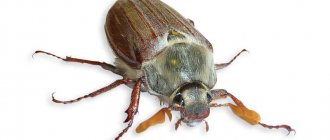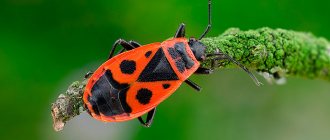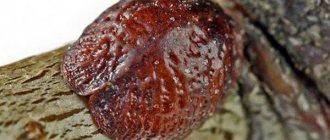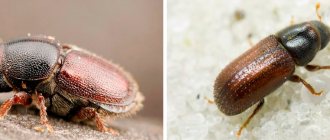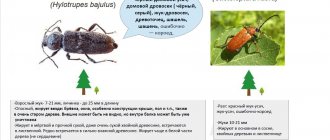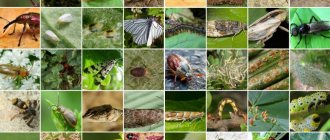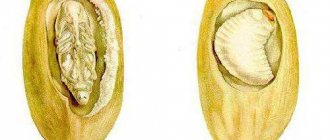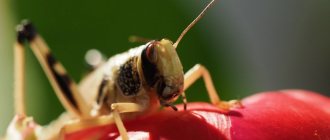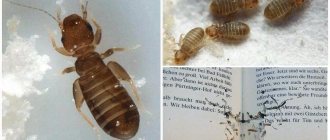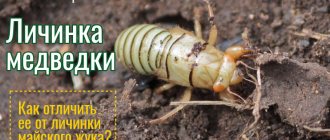Not only we humans rejoice at our harvest, some people also don’t mind feasting on our painstakingly grown products. Of course, there are many who want it, but let’s focus on one pest, which is popularly called the kuzka beetle. With his tenacious paws, with the virtuosity of a magician, he sorts through the spikelets, flying from one object to another.
With particular appetite it eats barley, rye, wheat, and wild cereal grains. The larvae are characterized by increased gluttony and, in addition to cereal crops, eat the roots of beets, tobacco, corn, potatoes, and sunflowers. What does this pest of the national economy look like and is there a way to combat it?!
You need to know the enemy by sight
In appearance, the parasite is very similar to the cockchafer. Belongs to the order Coleoptera (Coleoptera) and the family Lamellaridae (Scarabaeidae). If you look at the photo of the insect, the resemblance to the cockchafer is obvious. The body shape and color are the same, but there are still differences by which one can determine that this is a kuzka beetle. The photo below is a good example.
An adult has a small body length - about 10-16 mm, which, together with the head, is black. The elytra have a rich brown or yellow-red tint, and closer to the edges it turns into a dark brown tone. Females have an identifying feature - a small black spot with a triangular shape, located closer to the head.
The limbs, which are covered with gray hairs, are well developed and allow them to easily cling to ears of corn when flying from place to place. On the head you can see small antennae, and at their tips there are flat plates that, when spread, resemble a fan.
At the same time, there is a difference between male and female individuals: females have more rounded shapes, while the male kuzka beetle has hooked claws on its front legs.
Description
The body is large, stocky, in females with rounded sides, naked above; body length - 12.8-16 mm. Black; the head and pronotum have a green sheen and are covered with rather large frequent dotted lines. The pronotum of males has slightly rounded lateral margins, narrows more strongly in front and weaker behind, having its greatest width near the middle; its posterior angles are obtuse, directed somewhat backward; the pronotum of females has more rounded sides, greatest width near the middle, and obtuse posterior angles. The scutellum with a green tint is covered with small frequent dots.
The elytra in both sexes, with a number of short sparse setae along the lateral margin, weakly in males and strongly rounded on the sides in females, brown-yellow or red-brown, sometimes with darker areas, especially along the lateral margin and suture, in males larger partly monochromatic, rarely with traces of darkening at the scutellum or a black parascutellum spot; in females with a sharply defined black scuteal spot. The clypeus is extended forward, narrowed at the base, widened and raised towards the apex. The posterior part of the abdomen is covered with rather dense gray hairs; the underside is covered with dense, adjacent hairs on the abdomen. The large claw of the fore legs of males is almost in the middle below with a tooth. The antennae are 9-segmented.
Lifestyle
The entire life cycle, from egg laying to extinction, lasts just over 2 years. Moreover, the pest remains at the larval stage for quite a long time (22 months). After pupation, still young individuals emerge from the ground, and almost immediately they begin a period of active summer. According to various examples, it lasts from the last days of May until the beginning of August. Sometimes the deadline may shift in one direction by about two weeks.
Insects are especially active on sunny and hot days. Moreover, in an area of one square meter you can count from 3 to 5 individuals, or even more. When night comes, they hide in cracks in the soil or under lumps of earth. The Kuzka beetle likes to sleep longer and prefers to crawl out of its hiding places no earlier than 9 o’clock in the morning.
When beetles fly from place to place, they can be heard by their characteristic buzzing. The peak of strong appetite occurs at 3 pm. At this time the heat begins to subside. If the weather is cold outside, insects prefer to stay in their shelters.
black soldier fly breeding.
| BLACK LION!!! Conditions for breeding. |
| Click to view | For channel development: 4817760073634879 ===================== ================= If you are interested in more detailed information... |
| Tags: |
| Gennady Ivanov creates products from the larvae of the Black Lionfly | 29.RU |
| Click to view | A scientist from Arkhangelsk, Gennady Ivanov, breeds the larvae of Black Lionflies and prepares products from them... |
| Tags: |
| Industrial breeding of black soldier fly larvae in China |
| Click to view | At least three Chinese investment groups have poured millions of dollars into the construction of a waste disposal plant... |
| Tags: |
| Gennady Ivanov, NordTechSad: We qualitatively supplement traditional sources with protein from insects |
| Click to view | This year, our painstaking joint scientific work with the All-Russian Institute of Animal Husbandry has been completed... |
| Tags: |
| #19 Black Lion. Growing live food part 1 |
| Click to view | Video about how to populate prepupa and insectarium and remove clutches. Come to my channel, there is a lot... |
| Tags: |
| BGV 3 Black Lion's egg substrate |
| Click to view | How to prepare a substrate for feeding the fry of the Black Lionfly, Russian Federation, Krasnodar region, .g. Novorossiysk My... |
| Tags: |
| Plant for the production of black soldier fly and maggot 2022 1 |
| Click to view | Plant for growing Black Soldier Fly larvae and fishing maggots, BLK... |
| Tags: |
| Black soldier fly, feeding maggots (continuation of experiments) |
| Click to view | Processing of animal waste, breeding of maggots. Purchasing larvae, WhatsApp 89518406900. |
| Tags: |
| BGV 24 Black Lion's larvae development rates |
| Click to view | Answers to questions from viewers of the Russian Federation, Krasnodar region, .g. Novorossiysk My tel: +79184568380 mail: … |
| Tags: |
| Black soldier fly (Hermetici illucens) as a forage crop |
| Click to view | You can purchase fodder fly at any life stage, as well as in dry form, from the guys |
| Tags: |
| Maggots or 6 minutes from the life of the Black Lion. Episode 1 (Intro) |
| Click to view | Episode one of a series of videos about breeding black soldier fly. In the future I plan to present some... |
| Tags: |
| Bread with added protein from precucoca Black Lion's |
| Click to view | Yeast-free bread with the addition of protein from the Black Lion to the starter. I compared how the starter fits... |
| Tags: |
| Maggot breeding – industrial biotechnology |
| Click to view | The film of the project “AgroBio Technologies” () talks about methods of processing and agricultural waste using lychee. |
| Tags: |
| Recommendations for storing Silver Fish maggots |
| Click to view | The video, created by the Silver Fish company, talks about how to correctly and for a long time... |
| Tags: |
| growing maggots from A to Z part-1. |
| Click to view | This form shows how you can breed maggots at home during the cold season, it’s all simple... |
| Tags: |
| black soldier fly eggs reproduction center |
| Click to view | Breeding maggots at home Sawdust or Hercules Test Video Full HDTest with boiled and raw eggs… |
| Tags: |
| Breeding maggots at home Sawdust or Hercules Test Video Full HD |
| Click to view | Continuation of the series about a device for express breeding of food crops for ants. Incubator for... |
| Tags: |
| breeding maggots outdoors in the warm season, part 3 |
| Click to view | Our group on the social network “VKONTAK TE” |
| Tags: |
| Removal of food insects. Two ways to extract flies. |
| Click to view | Application of zoohumus from black soldier fly larvae as fertilizer. |
| Tags: |
| I prepare worms and maggots for stores |
| Click to view | Black soldier fly, black maggot, maggot for fishing, management of food insects, tilization. .. |
| Tags: |
| Black soldier fly zoohumus |
| Click to view | As they say, nothing personal, I just need a link to the video for the site... |
| Tags: |
| Breeding black soldier fly maggots. Black soldier fly |
| Click to view | Unusual business idea. Growing flies for human benefit. Business with minimal investment. Unbelievable... |
| Tags: |
| The first hours of life of a maggot, a black soldier larva |
| Click to view | A method for separating the white larva of the Black Lionfly from the substrate. Russian Federation, Krasnodar region, .g. Novorossiy with... |
| Tags: |
| Black soldier fly larvae (just need a Youtube video for the site) black soldier fly (BSFL) |
| Click to view | Production of fly larvae for the preparation of animal feed. |
| Tags: |
| Business idea Growing flies for human benefit” rel=”spf-prefetch |
| Click to view | Description missing |
| Tags: |
| BGV 25 Black Lion, separation from the substrate, for fishing” rel=”spf-prefetch |
| Click to view | Description missing |
| Tags: |
| Vesti Lipetsk 04/19/2016 story about flies” rel=”spf-prefetch |
Reproduction
The mating period begins two weeks after the beetles emerge; the process itself occurs on plants. After which the female leaves to lay eggs. Typically, the number of females exceeds the number of males by two times.
In order to lay its offspring, the sow grass (female) burrows into the ground (mainly the soil type is chosen) to a depth of 15 cm, directly under the place where it previously fed. At the same time, she does not lay eggs all at once, but usually in 2-3 batches. Each clutch contains 30-40 embryos. Thus, the female's fertility can reach more than 100 eggs. Having finished the job, the mother dies there.
In appearance, the eggs have a matte white tint and an oval shape, and on top you can see a dense leathery shell. The size is very small - no more than 2 mm.
Habitat
The bread ground beetle is a pest of cereal crops. It lives mostly in steppe and forest-steppe territories, right up to the southern borders of Polesie.
Based on the number and degree of damage to the crop, experts distinguish two types of zones: constant and cyclical damage.
Insect activity is more pronounced at night. During the day it can hide under stones or in burrows. However, if the ground beetle is in the apartment, then the darkened areas of the room, often under furniture, become its refuge.
In nature, the beetle lives near fields, in old straw dumps, and also in places where grain has been scattered.
The ground beetle's favorite delicacy is crops of wheat, rye or barley. In the absence of these, they can feed on corn, oats and leeks.
Stages of development
Beetles go through several stages of development:
- eggs;
- larvae;
- pupae;
- adult.
Egg maturation takes up to three weeks. At the same time, a large amount of moisture, as well as its lack, has a detrimental effect on the offspring. The hatched larvae are dazzlingly white, but as they mature, they darken. For greater clarity, the Kuzka beetle is shown below. The photo shows what it looks like in the larval phase.
The head of the adult larva becomes darker. They first shed their skin at the end of summer, and the following year they undergo two more molts.
The larvae live primarily in the ground, and the depth to which they dive depends on the degree of humidity and surrounding temperature conditions. In spring and autumn they lie at a depth of 1-5 cm, almost at the very surface, and are very easy to detect. But if there is a drought or frost, the larvae go deeper by 25-30 cm. In cold regions, they burrow even deeper for the winter - about 80 cm.
The source of food for small larvae are small roots or rotting plant debris that just fall into their hands. The diet of older larvae consists of plant roots. All bread beetle larvae that have successfully passed natural selection after living in the ground for two years begin to prepare for the next stage.
To transform into a pupa, the larva creates an oval shelter for itself at a depth of up to 15 cm. At this moment, they become especially vulnerable to light, as well as to changes in temperature and humidity.
The adult stage occurs after 2-3 weeks of pupal maturation. However, at first, young beetles still have soft elytra and the cover is not yet strong enough. The young individuals still spend several days in the ground until they are completely strong, and then they come to the surface. After which you can catch the kuzka beetle on the wheat while eating.
Kuzka bread and Kuzka's mother: historical facts and hypotheses
In searching for the origin of the name “Kuzka”, I came across a funny hypothesis that does not answer the question, but offers an interpretation of the expression “show Kuzka’s mother.”
A certain candidate of philological sciences Nikolai Pavlov says the following:
– Kuzka’s mother is an old and very figurative peasant expression. “Kuzka” in Rus' has long been the name for the grain beetle, a terrible enemy of grain. Its larva - the same "Kuzka's mother" - lives very secretly, it is almost impossible to get to it.
A completely acceptable explanation, considering that kuzka at one time greatly ruined the lives of the peasants.
On one forum it is said that in Dahl’s dictionary there is no mention of either Kuzka or his mother, and an interesting historical and entomological reference is provided.
The southern Russian and Hungarian steppes are considered the homeland of kuzka. Previously, they were huge spaces covered mainly with feather grass. But wheatgrass - the main food of the wheatgrass in the wild - did not grow there.
As the steppes were cultivated, wheatgrass began to grow well in plowed but unsown fields (fallow lands), and the grain grass appeared to have a vast field of activity (moreover, a “field” in both the literal and figurative senses).
Kama Sutra pieces of bread
And then our beetles tried wheat, rye and barley and quickly realized that they would be much sweeter than wheatgrass, cover vast areas thanks to human efforts and, what is especially pleasant, are available for much longer periods than wheatgrass, to which they were previously attached life cycle.
Actually, this is where the victorious march of the grain crop across the Russian land began.
All of the above events took place at the turn of the 18th-19th centuries, and the first indications of the dangers of the bread beetle appeared in the 1840s. This is a possible explanation for the absence of the expression in Dahl’s dictionary and, accordingly, confirmation of Nikolai Pavlov’s hypothesis voiced above.
Distribution area
The seemingly cute beetle gives many gardeners a lot of trouble. These parasites have adapted to live in Asia and Europe. But their most favorite place is the southern part of Russia and the countries of Western Europe, mainly in Italy and Hungary. But they also like places like the Balkan Peninsula, Siberia and Asia Minor.
On the territory of the CIS countries, they cause serious inconvenience to residents of Podolsk, Kherson, Ekaterinoslav, Kharkov regions, including a number of other areas. But over the past 30 years, their habitat zone has expanded somewhat towards the northeast: Vladimir, Saratov, Kazan regions. Beetles also feel good in the Caucasus or Transcaucasia.
The article was compiled using the following materials:
Literary sources:
1.
Vasilyev V.P. Pests of agricultural crops and forest plantations: In 3 volumes /Under the general title. ed. V.P. Vasilyeva.—2nd ed., revised. and additional - T. 1. Harmful nematodes, mollusks, arthropods / Ed. volumes V.G. Dolin. - K.: Harvest, 1987. - 440 pp.: ill. OK
2.
Vereshchagin L.N. Pests and diseases of cereal crops. - K.: Univest Marketing, 2001. -128 p.
3.
State catalog of pesticides and agrochemicals approved for use on the territory of the Russian Federation, 2015. Ministry of Agriculture of the Russian Federation (Ministry of Agriculture of Russia) Download >>>
4.
Kryzhanovsky O.L., Insects and mites - pests of agricultural crops. Volume II. Coleoptera. L: Publishing house “Nauka”, 1974.- 336 p.
5.
Mamaev B. M., Medvedev L. N. Key to insects of the European part of the USSR. - M., Education, 1976 - 304 p.
6.
Medvedev S.I. Fauna of the USSR. Coleoptera. Volume X. Issue 3. Lamellars (Scarabeidae). Subfamily Rutelinae (bread beetles and related groups), Publishing House of the USSR Academy of Sciences, Moscow-Leningrad, 1949 – 380 p.
7.
Orlov V.N. Pests of cereal crops. – M. Printed City, 2006 – 104 p.
8.
Polyakov I. Ya. Forecast of the development of pests and diseases of agricultural crops (with a workshop). - L.: “Kolos”, Leningrad branch, 1984. - 318 p.
9.
Striganova B. R., Zakharov A. A. Five-language dictionary of animal names: Insects. Latin-Russian-English-German-French. - M.: RUSSO, 2000. - 560 p.
Images (reworked):
10.
Benada Y. Atlas of diseases and pests of oilseeds. A team of authors led by J. Benada, I. Shediva, J. Spacek. Artist F. Severa. – Prague: State Publishing House of Agricultural Literature, 1968. – 200 pp., illus. Illustrations from the book. ©
Collapse List of all sources
Harm from a beetle
The damage caused by the goose beetle is not inferior in terms of damage to its competitor, the Colorado insect. The only difference between them is that the first specializes mainly in cereal crops, while Leptinotarsa decemlineata eats potato leaves.
The damage caused by the beetle is unimaginable, and damage to cereals is caused not only by adults, but also by larvae. Despite its short life cycle, one mature beetle is capable of eating up to 180 grains (or 10 spikelets). And if you imagine how many there are in total, then what will be the crop loss?! Moreover, the main danger lies not only in eating grains, but also in the fact that beetles are able to knock them off the ears to the ground. In this regard, the number 180 can increase to 400.
According to average expert estimates, the bread beetle is capable of destroying a crop of 1.1 hectares of winter cereal. Spring wheat may suffer even more – up to 2.3 hectares.
Varieties
Today there are two main categories of dung beetles:
- Coprophaga. This group included beetles with a large chest shield and strong tibiae of the front legs, allowing them to quickly carry out digging functions. Some individuals have very pronounced signs of sexual differences.
- Ateuchus (Scarabaeus). The main difference from the first group is that the head shield of these beetles is a semicircle, and the eyes are divided in two. The size of the largest individuals does not exceed 4 cm. They are most widespread in Southern Europe (including Russia) and in the northern part of Africa.
The only difference between them is that the beetles of the first group have a leathery, covered upper lip and jaw, while the second group has a hard and uncovered upper lip and jaw.
Types of dung beetles:
- Egyptian sacred dung beetle.
- Egyptian copr.
- Gravedigger beetle.
- Colorado beetle.
- Rhinoceros beetle.
- Common dung beetle.
Is it possible to protect your crop?
The war against such parasites has been going on for a long time and is associated with certain difficulties. The fact is that beetles spend most of their lives in the larval stage and burrow to a certain depth, which reliably hides them from detection.
In modern agriculture, different methods of control are used:
- carrying out inter-row tillage (the best period is the last days of May - the first days of June);
- harvesting as early as possible;
- use of insecticides (effectiveness has been proven over 10 years of use);
- carrying out early autumn plowing.
Among insecticides, products such as Metaphos, Chlorophos, Sumition and Decis Extra are very popular.
Only this measure of combating the black beetle is carried out approximately 20 days before the start of harvest, no later. In this case, the death of insects reaches 90%.
Cereal aphids
Ordinary
The common cereal aphid is a herbivorous sucking insect. Feeding on plant juices, it damages the leaves, which as a result turn yellow and dry out. The growth of crops slows down, yields drop, and cereals affected by aphids often die completely.
The main methods of control include:
- stubble peeling, deep plowing of fields in autumn;
- use of potash and phosphorus fertilizers;
- early sowing of spring grains;
- treating fields with insecticides.
Big
This pest lives on all cereal crops, inhabiting stems, leaves and ears. The body is about 2.5-3 mm long, green with a reddish tint. It reproduces quickly: under favorable conditions, 10-12 new generations of aphids can appear in one summer.
Cereal aphids cause damage to winter and spring wheat and barley, as well as rye, oats and corn.
Pest control:
- stubble peeling and fall plowing;
- early sowing of spring crops;
- the use of fertilizers that accelerate the development of plants and make them more resistant to damage.
The enemy of my enemy is my friend
Fortunately, the pest has enemies whom we can call our friends. Kozka larvae can be eaten by shrews and other beetles. When plowing fields, they may appear on the surface, which can attract the attention of some birds: gulls, rooks, ravens and jackdaws.
Other birds will not refuse to feast on adult beetles:
- starlings;
- sparrows;
- shrikes;
- squints;
- storks;
- hoopoes.
Predatory flies and wasps also pose a serious danger to cereal lovers. Small worms can get inside the larvae, which also leads to their death. Thanks to them, the number of pests does not go off scale.
The reason for the mass development of the national pest
As paradoxical as it may sound, the reason for the large-scale development of these parasites comes from ourselves. Some time ago, the diet of the beetle beetle included only wheatgrass, and the number of individuals was minimal, since after its flowering there was no other suitable food.
Over the years, agriculture began to develop, which gave insects the opportunity to taste new foods. As you can understand, they especially liked it. In addition, poor cultivation of fields only benefits pests.
Maliciousness
The grain beetle damages wheat, barley, rye and wild cereals. The main damage is caused by beetles, eating ripening grains and knocking out mature ones. Larvae of the second year of life damage the root system of various plants.[7]
The economic threshold of harmfulness is determined by examining fields during the flowering period - grain filling and is 3-5 beetles per square meter of land.[8]
Pesticides
For spraying during the growing season:
Systemic and contact-intestinal insecticide:
Broad-spectrum insecticide:
3rd generation pyrethroid:

